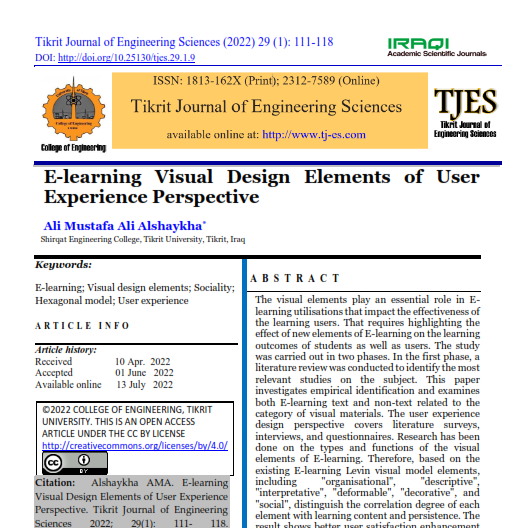E-learning Visual Design Elements of User Experience Perspective
Main Article Content
Abstract
The visual elements play an essential role in E-learning utilisations that impact the effectiveness of the learning users. That requires highlighting the effect of new elements of E-learning on the learning outcomes of students as well as users. The study was carried out in two phases. In the first phase, a literature review was conducted to identify the most relevant studies on the subject. This paper investigates empirical identification and examines both E-learning text and non-text related to the category of visual materials. The user experience design perspective covers literature surveys, interviews, and questionnaires. Research has been done on the types and functions of the visual elements of E-learning. Therefore, based on the existing E-learning Levin visual model elements, including "organisational", "descriptive", "interpretative", "deformable", "decorative", and "social", distinguish the correlation degree of each element with learning content and persistence. The result shows better user satisfaction enhancement and promotion of E-learning's learning effectiveness and persistence. In addition, from the perspective of user experience, it is found that social elements are the potential needs of users, and sociality is one of the characteristics of digital learning.
Metrics
Article Details

This work is licensed under a Creative Commons Attribution 4.0 International License.
THIS IS AN OPEN ACCESS ARTICLE UNDER THE CC BY LICENSE http://creativecommons.org/licenses/by/4.0/
Plaudit
References
REFERENCES
Renkl, Scheiter K. Studying visual displays: How to instructionally support learning. Educational Psychology Review, 2017; 29: 599-621. DOI: https://doi.org/10.1007/s10648-015-9340-4
Mayer RE. Using multimedia for e‐learning, Journal of Computer Assisted Learning, 2017 33: 403-423. DOI: https://doi.org/10.1111/jcal.12197
Ainsworth S, Loizou AT. The effects of self‐explaining when learning with text or diagrams. Cognitive science, 2003; 27 : 669-681. DOI: https://doi.org/10.1207/s15516709cog2704_5
A.I.S, Alshaykha AMA. Short-Term Traffic Flow Prediction Model Based On K-Nearest Neighbors and Deep Learning Method System. Journal of Mechanical Engineering Research and Developments, 2021; 44: 10.
Carney RN, Levin JR. Pictorial illustrations still improve students' learning from text. Educational Psychology Review, 2002; 14: 5-26. DOI: https://doi.org/10.1023/A:1013176309260
Mayer R, Mayer RE. The Cambridge handbook of multimedia learning, Cambridge university press, 2005. DOI: https://doi.org/10.1017/CBO9780511816819
Can T, Simsek I. The use of 3D virtual learning environments in training foreign language pre-service teachers. Turkish Online Journal of Distance Education, 2015; 16: 114-124. DOI: https://doi.org/10.17718/tojde.53012
Eitel A, Scheiter K, Schueler A. How inspecting a picture affects processing of text in multimedia learning. Applied Cognitive Psychology, 2013; 27: 451-461. DOI: https://doi.org/10.1002/acp.2922
Gibbons S, Peters T, Bryan R. E-book functionality white paper. Retrieved January, 2003; 5: 2016.
Bates AT. Technology. e-learning and distance education. Routledge, 2005. DOI: https://doi.org/10.4324/9780203463772
Søndergaard E, Reventlow S. Drawing as a facilitating approach when conducting research among children. International Journal of Qualitative Methods, 2019: 18: 1609406918822558. DOI: https://doi.org/10.1177/1609406918822558
Urdan TA, Weggen CC. Corporate elearning: Exploring a new frontier, (2000).
Rosenberg MJ, Foshay R. E‐learning: Strategies for delivering knowledge in the digital age. Wiley Online Library, 2002. DOI: https://doi.org/10.1002/pfi.4140410512
Berry J. Traditional training fades in favor of e-learning. Internetweek, 2000; 800: 33-35.
Masie E. Learning Perspectives. TechLearn TRENDS, 2001; 202.
Branch RM, Mané CE, Shin MY. Effect of graphic element type on visual perceptions of curvilinear and rectilinear flow diagrams. Journal of Visual Literacy, 2018; 37: 119-136. DOI: https://doi.org/10.1080/1051144X.2018.1493249
Garrison DR. E-learning in the 21st century: A framework for research and practice. Routledge, 2011. DOI: https://doi.org/10.4324/9780203838761
Clark RC, Mayer RE. E-learning and the science of instruction: Proven guidelines for consumers and designers of multimedia learning. john Wiley & sons, 2016. DOI: https://doi.org/10.1002/9781119239086
Al-Samarraie H, Teng BK, Alzahrani AI, Alalwan N. E-learning continuance satisfaction in higher education: a unified perspective from instructors and students. Studies in higher education, 2018; 43: 2003-2019. DOI: https://doi.org/10.1080/03075079.2017.1298088
Levin JR. On functions of pictures in prose. Neuropsychological and cognitive processes in reading, 1981; 203. DOI: https://doi.org/10.1016/B978-0-12-185030-2.50013-5
Mayer RE. based principles for learning with animation, in: Learning with animation: Research implications for design. Cambridge University Press New York, NY, 2008; _: 30-46.
Levie WH, Lentz R, Effects of text illustrations: A review of research. Ectj, 1982; 30: 195-232. DOI: https://doi.org/10.1007/BF02765184
R.S. Yan. A Study on the Design of the Vision-Centered Digital Reading Interface. Advanced Materials Research, 2011; 308: 328-331. DOI: https://doi.org/10.4028/www.scientific.net/AMR.308-310.328
R.E. Mayer. Multimedia learning, in: Psychology of learning and motivation. Elsevier, 2002; 41: 85-139. DOI: https://doi.org/10.1016/S0079-7421(02)80005-6
Alshaykha, A., Al-yousif S., Hameed, D., Hamoud, A., Overcoming Unemployment of Computer Science Alumni through Mobile Apps Utilization. Webology, 2022; 19 : 3192-3211. DOI: https://doi.org/10.14704/WEB/V19I1/WEB19211
Hameed, D., Tahseen F.l, Alshaykha A., Ghanim H.,Harith A., Automatic evaluating of Russian-Arabic machine translation quality using METEOR method. AIP Conference Proceedings, 2022; 2386(1):040036. DOI: https://doi.org/10.1063/5.0067018
Alshaykha, A. and Shaban, A. Short-Term Traffic Flow Prediction Model Based On K-Nearest Neighbors and Deep Learning Method. Journal of Mechanical Engineering Research and Developments, 2021; 44(6):113-122.
Fawaz, Mirna, and Ali Samaha. E‐learning: Depression, anxiety, and stress symptomatology among Lebanese university students during COVID‐19 quarantine. Nursing forum, 2021; 56(1). DOI: https://doi.org/10.1111/nuf.12521
Zhao, Yang, et al. "Do cultural differences affect users’e‐learning adoption? A meta‐analysis. British Journal of Educational Technology,2021; 52(1): 20-41. DOI: https://doi.org/10.1111/bjet.13002
Brown, Andrew R., and Bradley D. Voltz. Elements of effective e-learning design. The International Review of Research in Open and Distributed Learning, 2005; 6(1). DOI: https://doi.org/10.19173/irrodl.v6i1.217
Alias, Nursyahidah, et al. E-Learning successful elements for higher learning institution in Malaysia. Procedia-Social and Behavioral Sciences, 2012; 67: 484-489. DOI: https://doi.org/10.1016/j.sbspro.2012.11.353
Strmecki, Daniel, Andrija Bernik, and Danijel Radosevic. Gamification in E-Learning: Introducing Gamified Design Elements into E-Learning Systems. J. Comput. Sci, 2015; 11(12): 1108-1117. DOI: https://doi.org/10.3844/jcssp.2015.1108.1117
Lieberman, Matthew D. Social: Why our brains are wired to connect. OUP Oxford, 2013.





